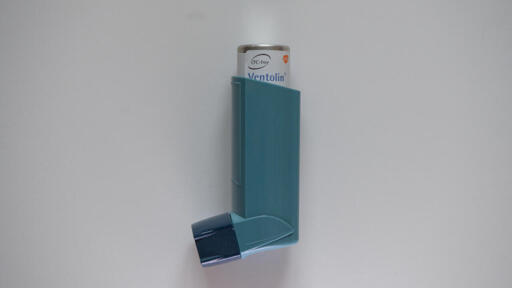Washington (AFP) – The inhalers people depend on to breathe are also warming the planet, producing annual emissions equivalent to more than half a million cars in the United States alone, researchers said Monday in a major new study.
Using a national drug database, researchers at the University of California, Los Angeles and Harvard analyzed global warming pollution from three types of inhalers used to treat asthma and chronic obstructive pulmonary disease (COPD) between 2014 and 2024.
The study, published in the Journal of the American Medical Association, found that inhalers used by US patients with commercial insurance and the government-run programs Medicaid and Medicare generated 24.9 million metric tons of carbon dioxide equivalent over the decade.
Metered-dose inhalers, or “puffers,” were by far the most damaging, accounting for 98 percent of emissions. They use pressurized canisters containing hydrofluoroalkane (HFA) propellants – potent greenhouse gases – to deliver medication.
By contrast, dry powder and soft mist inhalers don’t use propellants. The former rely on a patient’s breath to release medicine, and the latter turn liquid into a fine spray – making both far less harmful to the planet.
“Five hundred and thirty thousand cars on the road each year is a lot, and I think this is a really important topic because it’s fixable – there are easy ways to reduce emissions,” lead author William Feldman, a pulmonologist and researcher at UCLA, told AFP.
Medically, only a small fraction of patients require metered-dose inhalers.
Very young children need spacers – valved chambers that help deliver medicine to the lungs – and these only work with metered-dose devices. Frail older adults with weak lungs may also need puffers because they can’t generate enough inhalation force.
“But the vast majority of people could use dry powder or soft mist inhalers,” Feldman said, noting that countries such as Sweden and Japan use alternative inhalers without any loss in health outcomes.
The slower US uptake of greener inhalers, he added, stems from insurance and market barriers.
A dry-powder version of albuterol, the most commonly used inhaler drug, exists but is often not covered by insurance, making it more expensive. Another drug, budesonide-formoterol, is widely sold in dry-powder form in Europe, which is not available in the United States.
Feldman emphasized that the goal of the research is not to blame patients but to highlight the need for policy and pricing reform.
“We absolutely do not want to stigmatize patients with asthma and COPD,” he said.
“I think it’s incumbent upon us as a society to get those medications to the patients in a sustainable way, and that ultimately falls to the highest levels.”
A related JAMA commentary authored by Alexander Rabin of the University of Michigan and others echoed that insurers and policymakers must ensure lower-emission inhalers are affordable and accessible for all.
They warned that several new low-global-warming metered-dose inhalers are expected to launch in the US as high-priced brand-name products, “raising the risk that patients without robust insurance coverage…could be left behind.”
The study, published in the Journal of the American Medical Association, found that inhalers used by US patients with commercial insurance and the government-run programs Medicaid and Medicare generated 24.9 million metric tons of carbon dioxide equivalent over the decade.
So a drop in the bucket compared to corporate pollution, eh?
My god, hasn’t anyone considered the damage being done by keeping people alive and healthy! /s
three types of inhalers used to treat asthma and chronic obstructive pulmonary disease (COPD) between 2014 and 2024.
Oh and a bonus, it’s tied to diseases whose numbers increase with increased pollution.
But nevermind, it’s all the poor schmucks who are trying to stay alive who are the problem. /s
If you’d read the article (or even the excerpt that OP included), the author firmly places the blame on the American medical and insurance industry that is refusing to cover inhaler versions without greenhouse gas propellants.
Did you even read it?
But the vast majority of people could use dry powder or soft mist inhalers,” Feldman said, noting that countries such as Sweden and Japan use alternative inhalers without any loss in health outcomes.
Feldman emphasized that the goal of the research is not to blame patients but to highlight the need for policy and pricing reform.
How about actually RTFA first before you go off making such an ass of yourself next time? Nowhere did anyone blame the patients, except you.
It’s worth noting that the article suggests a lot of people are only on this type of inhaler due to insurer laziness.
I suggest read the original study instead of a paper’s interpretation of it. They suggest action, and that’s changing the suggested inhalers people use in most cases. It’s not “blame people for thing”, it’s “here’s a problem and how we can dramatically reduce it with some minor systemic changes”
All but 2 therapeutic classes (short-acting muscarinic antagonists and ICS-SABAs) had dry powder and/or soft mist inhalers available. If patients during the study period had received the inhalers with the lowest emissions intensity available at the time in each therapeutic class, total emissions would have decreased by 92%, from 24.9 million mtCO2e to 2.1 million mtCO2e (eTable 6 in Supplement 1).
[…]
This study identifies a high ceiling for potential climate-related gains from switching patients to therapeutically equivalent alternatives. Any such efforts to shift prescribing will likely depend on broadscale formulary changes—and the policies required to incentivize such changes—rather than just individual actions by patients and physicians, who may be limited by payer formularies when choosing particular inhalers
That sort of thinking kills positive change by distracting with bigger problems.
Yes it’s a small thing compared to XYZ, but it’s still worth doing.
CFC free metered inhalers exist
EDIT: nvm… they seem to be talking about HFA inhalers
I’m assuming they moved to HFAs/HFCs for basically the same reasons refrigerants did: still non-toxic, still non-flammable, now no ozone concerns.
If they want to replace them with low-GHG alternatives it starts getting tricky.
Hydrocarbons are great but flammable, and flames inside your lungs seems even more exciting than some propane leaking out of your fridge.
Hydrofluoroolefins (1234yf and 1234ze) are probably about to be banned as PFOA precursors, although Wikipedia says the latter might be introduced in inhalers…
CO2 doesn’t liquefy and breathing it in is going to make you feel like you’re suffocating.
I’m picking HFCs are going to stick around in medical applications for a while where dust/liquid options aren’t feasible.
That or returning to some kind of blower mechanism for ambient air.





